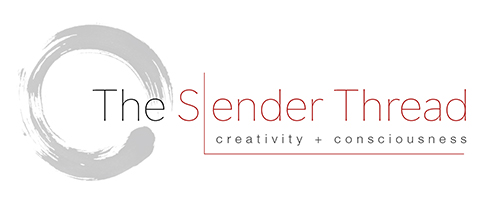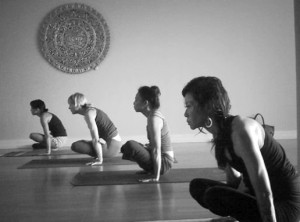These are the questions we explored in our recent classes in creativity and yoga. Both creativity and yoga have as one of their basic needs that we learn to come into greater contact with the body, experience its sensation (which has the same root as the word, senses), and open to its knowledge. Through relaxation of the body, through allowing our attention to descend inward, we begin to loosen our attachment to surface thought and the myriad of shiny objects, both inner and outer, that draw, we could even say steal our awareness. Through including the body in our field of awareness, we can begin to find hints of our natural wisdom, germs of our authentic way of being and expressing ourselves. This is not, of course, as simple as it sounds.
During the classes, we focused on entering the body, seeking relaxation in movement, and seeking inner awareness while looking outward. In the class exercises, we offered a short meditation practice prior to looking at images or engaging the simple exercises designed to enhance creativity and cultivate seeing. This is well and good, and the participants responded enthusiastically to these exercises and began making individual discoveries. However, one of the central obstacles soon became clear: we want to be clever, to be admired, to be liked. This was true for students and faculty alike. Our egos got in the way.
In the creativity portion of the class, we attempted to counterbalance this by offering one simple dictum gleaned from actor Alan Arkin’s improvisational workshops: “The rules for this exercise that I want you to pay strict attention to are: I don’t want to see anything interesting and I don’t want to see anything creative.” The participants immediately felt a sense of freedom from needing to look good. Arkin explains this liberation, “I don’t have to be the thing that I wanted this workshop to accomplish for me.” Paradoxically, as soon as they stopped trying to be clever or interesting, they relaxed more into being simply themselves. We do not need to try so hard. Arkin believes “that it is our nature to be creative and that not being creative is the aberration.”
Through entering the body and coming to a more relaxed presence, a different quality of energy began to be infused in the classroom: an alertness, a quieting, a natural turning inward. Yoga was introduced for the purpose of bringing artists and creative people more deeply into their bodies and senses, two essential elements in the creative process. Barring modern, hybrid forms of yoga that deal primarily with physical health and fitness, Patanajli, the compiler of the Yoga Sutras, states early on that the purpose of yoga is to “still the turning of thoughts.” A real yoga practice involves methods that cultivate a movement away from the external world and a movement inward towards our authentic selves.
We observed a tendency in both the yoga and the creative exercises to be overly identified with how we appear to others, dissociated from the body, and absorbed by the external environment. The “I” and “my” play a large role in one’s life experience. We take ownership of certain aspects of our lives: my body, my relationships, and my time. The external world can also captivate us to such an extent that we do not know ourselves apart from it. For example, this phenomenon manifests in recent years as a preoccupation with technology—text messaging immediately before and after class, the sound of phones ringing, and the sound of voicemail alerts going off during class.
The challenging lesson in the beginning stages of yoga is found in making the effort to suspend attention to the gross external movements of the mind and resisting our attraction to the external environment. Students are instructed to employ their sense organs in order to keep their awareness centered on their gross physical bodies. The gaze (drishti) should stay fixed in a single place, generally on the student’s body or mat, and fidgeting should be minimized. Practice at this early stage can sometimes appear to be rigid or overly austere. New students generally need to work through physical layers of tightness, weakness, or fatigue before having a more complete experience of the breath, which brings a meditative quality to practice that bridges the gap between outer and inner experience. As one’s practice matures, one’s awareness drops further and further inward as they become aware of the subtler aspects of body, mind, and energy.
Jacob Needleman reflects on the location of attention within the body: We turn with astonishment to find, for example, in the Orthodox Christian tradition, directives such as that of Gregory Palamas in the eleventh century: ‘You see brother, that not only spiritual, but general human reasoning shows the need to recognize it as imperative that those who wish to belong to themselves . . . should lead the mind inside the body and hold it there. It is not out of place to teach even beginners to keep attention in themselves. . . .’
The striving toward a centered presence of the human body is necessary for those who wish to belong to themselves. There is a force in the words alone: I wish to belong to myself. Without the participation of the body, we are nothing more than thinking machines, incapable of the comprehensive understanding and genuine insight that derive from an inclusive attention. In the centered presence of the body, we begin to come home to our true nature and a heightened sense of being.


1 Comment
Comments are closed.